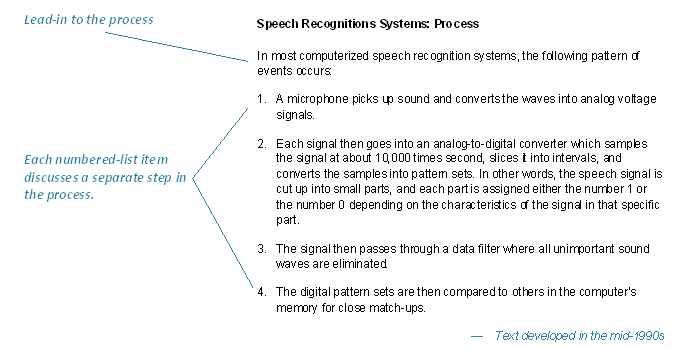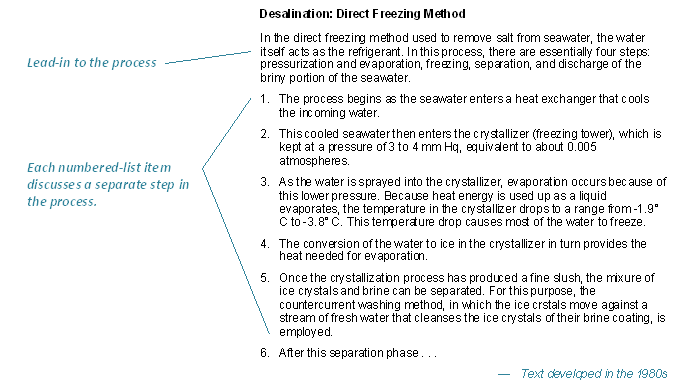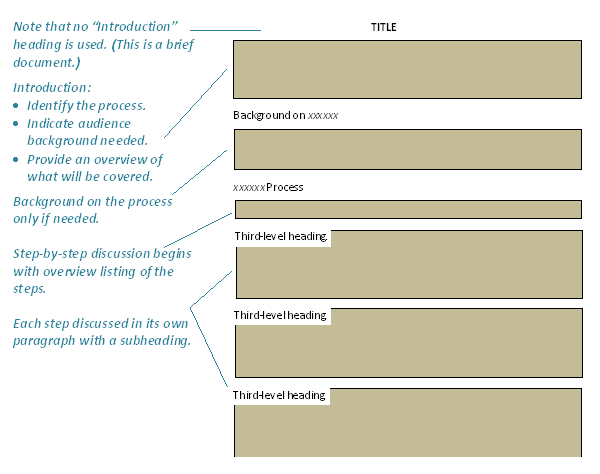Please click here to help David McMurrey pay for web hosting:
Donate any small amount you can !
Online Technical Writing will remain free.
In technical writing, process narrative is one of the most important kinds of prose: people need to know how things happen, how things work, how to operate things, and how to perform certain actions. A narration tells how something occurs over a period of historical time. A process is an event or set of events that can be performed or that occurs regularly or repeatedly. The words "procedure" and "routine" are closely related. When you "narrate" a "process," you explain how something works or how something occurs. We'll use "process discussion" here.
Note: See examples of process narratives.
What Is a Process?
Process narrative is an information structure—it's one of those fundamental combinations of content and organizational patterns you use in many different situations in technical writing. For example, instructions are an application of technical writing; instructions make heavy use of process narrative. (See the chapter on instructions.)
The focus of this chapter is some basic guidelines for writing noninstructional process narratives. These process narratives answer such questions as:
- How does this mechanism work?
- What are the typical steps in this natural, mechanical, social, biological, psychological phenomenon?
- How does this event (mechanical, natural, human, social) happen?
When we ask questions like these, we expect a systematic step-by-step explanation of how the mechanism works or how the phenomenon happens. We're not looking to perform it ourselves, just to understand it. In another chapter, you read about causal narratives. These are closely related to process narratives. In causal narratives, we're interested in why something happens, what causes it, what its results or consequences are. In process narratives, we are interested in how something happens, how it works, in a step-by-step fashion. Often the distinction between these two is blurry.

Process narrative. Step by step, this text explains how computers "recognize" speech.
Process narratives focus on things like formation of lightning, snow, hurricanes, cold fronts, tornadoes; gestation of a human embryo; pollination of a flower; automatic operations of a photocopier or a computer; occurrence of supernova, black holes, red giants, or white dwarfs. Process narratives explain the workings of such mechanisms as automobile batteries, light bulbs, telephones, televisions, microwave ovens, stereo receivers.
As mentioned previously, the focus in this chapter is noninstructional process. However, while explaining how doctors perform open heart surgery or how a nuclear power plant operates might sound like instructions, they aren't! Normally, documents on these topics would give people an overview of what goes on in these processes. This next illustration conveys a general idea of how seawater is converted into fresh water:

Process narrative. Step by step, this text discusses a method for the desalination of seawater.
How to Divide the Process into Steps?
When you write a process narrative—whether it's a single paragraph or a whole report—one of the most important tasks is to divide the process into its main steps, phases, stages, or periods. There are of course other ways to handle a process narrative, but division by steps is usually the best. For example, you might try organizing a process narrative by the key parts of a mechanism. Use whichever plan seems to work best for your readers, topic, and purpose.
A step is one action or event (or a group of related ones) that is performed or that occurs in the process. Consider a simple process such as
making coffee with a drip coffee pot. Such an activity involves the following steps, each of which actually represents a group of actions:
Steps Individual actions (step 1)
1. Boiling the water --------------------->a. Finding the kettle and taking it to
2. Rinsing the coffee pot and the sink
the basket b. Turning on the water and rinsing
3. Measuring in the new coffee out the kettle
4. Pouring in the boiling water c. Filling up the kettle to the desired
amount
d. Turning off the water and walking to
the stove
e. Placing the kettle on a burner
f. Turning on the burner
g. Waiting for the water to boil
Obviously, no one needs to be told all these specific actions; the example shows that a step usually stands for a group of related specific actions or events. If you look back at the preceding desalination example, you see a more realistic example of this process of division into steps. The narrative focuses on four steps in the desalination process: (1) pressurization and evaporation, (2) freezing, (3) separation, and (4) discharge of the briny portion of the seawater.
How are process narratives used in technical documents? First and foremost, processes are typically explained in instructions. For some situations, explaining how a thing works is almost as effective as providing the direct step-by-step instructions. And in any case, people understand the actions they are performing better when they understand the actions behind those actions. Process narratives are also vital in new product documents—either internal (meant for the product's designers and marketers) or external (meant for the product's customers and users). And finally process narratives are important in scientific research literature. You can imagine researchers studying acid rain or oil spills—understanding these processes might lead to controlling them better.
How to Discuss the Steps?
When you discuss a process, your goal is to enable readers to understand how that process works, the typical events that occur in that process. You use any writing tools at your disposal to accomplish that end. One of the most common ways of explaining a process is to divide it into steps, phases, periods, stages. These are essentially time segments—groupings of closely related events or actions. Take a look at any of the examples in this chapter; you'll see process sentences everywhere.
However, most process narratives aren't much without explanations of the causes and effects operating behind them. For example, it's not terribly exciting to read that when tornadoes form, it gets cloudy, wind and rain and twisters occur, wrecking things. We want more that just the bare-bones process: we want to know what causes them to form, what are the conditions favorable to their formation, how they behave once formed, and of course what sorts of damage they cause.
Other sorts of information can supplement the discussion of processes as well:
- Description: Explain how things look before, during, or after the process, or any phase within the process.
- Definitions: Explain the meaning of any technical terms used in the narrative.
- Comparisons: Compare the process, any of its phases or outcomes, to something similar or something familiar to help readers understand.
- Examples: Provide examples of the process you are explaining. For example, in a narrative of tornadoes, examples of tornadoes in history can help.
Mitosis is the process of cell duplication, during which one cell gives rise to two identical daughter cells. The process consists of four main phases: prophase, metaphase, anaphase, and interphase.
|
Expanding example of process narrative. Information structures can work like an accordian—they can expand or collapse according to your needs. Click on the link in this example and see the expansion of the discussion of prophase.
How to Format Process Narratives?
Here are a few suggestions on format as they relate specifically to process narratives.
- Headings. If you write an extended process narrative and structure it by steps or phases, in other words, time segments, then the subheadings can be related to those steps or phases, as illustrated in the following schematic view of process narratives. If your process narrative has one section in which you explain the process and another in which you discuss some supplementary aspect of the process, your headings would need to indicate that structure as well. See the chapter on heading for details.
- Lists. Because they focus on sequences of events, process narratives are likely candidates for in-sentence and vertical numbered lists as the examples in this chapter show. See the chapter on lists for details.
- Graphics. Process narratives are prime territory for flow diagrams such as you see in some of the illustrations in this book. In these you give a spatial representation of things as they occur in time. Useful also are diagrams and drawings of the mechanisms that take part in the process. See the chapter on graphics for details.
- Style. You treat numbers, symbols, and abbreviations in process narratives the same as in any other technical document. Exact measurement values should be numerals, regardless whether they are below 10. See the chapter on style and mechanics for details.

Schematic of a process narrative. A typical or common model for the contents and organization—others are possible.
I would appreciate your thoughts, reactions, criticism regarding this chapter: response—David McMurrey

